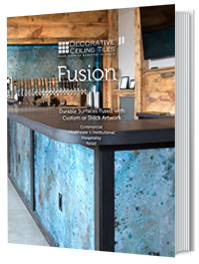What Materials Are Drop Ceiling Tiles Made Of?
Written by Milan Jara on 18th Aug 2022

What are drop ceiling tiles made of? The answer is a variety of materials with different properties. We outline what they are and the benefits of each.
Considered to be the “fifth wall” in any home, ceilings don’t get the love they deserve. The best part about your ceiling is that you can get creative in integrating it into the rest of the room. Ceilings can be aggregated, plastered, vaulted, or dropped for function or aesthetics. We teach you what drop ceiling tiles are made of to give you a list of options for your space.
Four Types of Drop Ceiling Tiles
Drop ceiling tiles come in four materials: plastic, acoustical, cork, and tin. Within these categories are subcategories broken down by installation, design, and use.
Acoustic Ceiling Tiles

Acoustic ceiling tiles make a room soundproof. They tend to be composed of fiberglass and installed using a drop ceiling method. Metal strapping spans your ceiling, with tiles hanging from straps or dropping into a ceiling grid system. That said, some companies make snap-together tiles without any visible straps.
Acoustic tile is often used for insulation since the same soundproofing materials also thermally insulate a room. Depending on the composition, you can lower heating and cooling costs in the room where you install them.
Most types of acoustic ceiling tile require professional installation to ensure its insulating and acoustic properties are intact. However, some acoustical ceiling tile brands can also be installed by homeowners.
Mineral Fiber Tiles
Ceiling tiles can use processed, natural, and recycled materials, like recycled newsprint, perlite, clay, starch, and fiberglass, and the quantities of the materials used vary depending on the tile’s characteristics.
Soft mineral fibers will have more fiberglass and mineral wool, allowing for some ceiling surface sound absorption but providing less insulation than stiff mineral fibers. Mineral fiber tiles contain additional clay, making them denser and heavier, thus providing better insulation.
Each material uses a water-based process to generate a finished product. Then, the tiles are cured, bound by heat, and cut to size with a laser. They are finished with water-based paint before being used to create decorative patterns.
Styrene
This material uses fiberglass textures and improves indoor air quality, acoustics, and light reflectance. You can make it into lightweight ceiling panels with varying rigidity, ranging from cloth panels to semi-rigid tiles and woven textures. Styrene provides a long-lasting ceiling that is low maintenance.
Styrofoam (Polystyrene)
Polystyrene offers acoustical benefits and insulation to any room. There are many attractive designs to select from, yet they are challenging to maintain. This material is not fire resistant, and some may add fuel to any fire in the home.
On the other hand, Styrofoam is a better insulator than other ceiling tiles, like pressed paper and metal. They provide a barrier from noise, add thermal insulation, and maintain the room's temperature well, keeping air cool in warmer seasons and warm when it is cold and leading to lower energy costs.
Tiles of this material are easy to install and lightweight, and homeowners can use them to cover stucco and popcorn ceilings.
Plastic Ceiling Tile

Plastic tiles are cost-effective and inexpensive when compared to tin ceiling tiles. They are available in embossed patterns featuring wreaths, flowers, and other repeating designs and provide a three-dimensional, geometric appearance.
Installing them is easy for any DIYer. Depending on your preference, you can nail them up or drop them into a suspended ceiling grid. The best part is that homeowners need not worry about dinging or denting tiles. You can paint them in the same finishes as tin if you want the look without the cost.
Tin Ceiling Tile

Tin ceiling tiles are beautiful and constructed of brass, aluminum, or copper. You can install them by nailing them up to a ceiling with overlapping edges or via drop-in methods.
Design-wise, they are generally repetitive, with popular choices for flowers, scrolls, geometric patterns, and vines.
The benefit of this material is that it is nonporous. These tiles rarely become stained because moisture and dirt have no place to go once they reach the surface. Mold and rust typically do not happen with this type of material, either. They can withstand fires and floods without damage.
These tiles come in the following materials:
- Tin: Low maintenance and only requires occasional surface dusting for cleaning. They offer fire protection as well.
- Aluminum: Eye-catching appearance and can be customized into stamped designs.
- Rustic steel: Moisture and resistant to fire.
- Copper: Environmentally friendly, durable, and impervious to bugs.
- Stainless steel: Durable and create a beautiful sheen reflecting the brightness of a room.
These tiles are a bit more challenging to install than plastic but are by no means difficult. Should a panel dent or nick, you can quickly repair it using auto body repair compounds and sculpting.
Cork Ceiling Tile
This eco-friendly solution will insulate your home. Cork is a naturally water-resistant and fire-resistant material that absorbs sound well, making them an excellent all-around tile for any home.
You can install these tiles using adhesives or a drop-in method. You can overlap them and install them in decorative designs or patterns. Experienced homeowners find this material easy to use, but some prefer a professional installation.
Drop ceiling tiles are created from various materials, depending on the type. Metals provide durability, fire and water resistance and are built to last, while others are beautiful to look at but require more maintenance. Most are simply stunning.
There are pros and cons to each type of material. Before selecting one for your home, consider both sides to find the best option.




